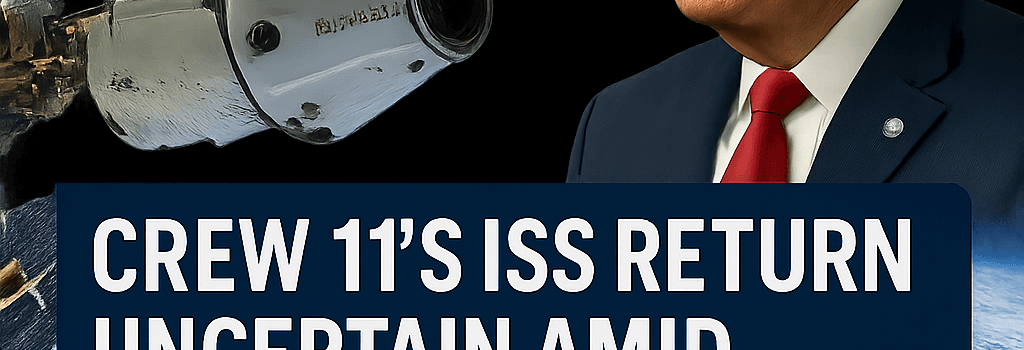Crew-11’s ISS Return Uncertain Amid Trump’s NASA Cutbacks

Updated: September 15, 2025 — Four astronauts launched to the International Space Station (ISS) on SpaceX Crew-11 now face an open-ended homecoming window as NASA navigates deep federal budget cuts and logistical shifts in Earth-side infrastructure.
Mission Overview and Launch Profile
On August 1, 2025 at 11:43 am EDT (15:43 UTC), NASA’s Crew-11 mission lifted off from the Kennedy Space Center aboard a Falcon 9 Block 5 rocket, delivering the Crew Dragon Endeavour to orbit on its 159th consecutive successful flight.
- Commander: Zena Cardman, geobiologist and first-time flier.
- Pilot: Mike Fincke, veteran of three prior missions (Soyuz, Shuttle).
- Specialist: Kimiya Yui, ex-fighter pilot and 2015 ISS veteran.
- Specialist: Oleg Platonov, Russian cosmonaut and RKA newcomer.
The Falcon 9 first stage conducted a boost-back burn before making a pinpoint landing at Landing Zone 1 (LZ-1)—the final recovery at that pad before SpaceX transitions to new on-site landing zones adjacent to Pads 39A and 40. Meanwhile, the second stage’s RL10C-2-derived Merline engine inserted Dragon into a 400 km circular orbit.
Automated Docking and On-Orbit Operations
Approximately 24 hours after launch, Crew Dragon utilized its High-Efficiency Deployable Vehicle Adapter (HEDVAc) and NASA Docking System (NDS) to perform an autonomous rendezvous, culminating in a soft‐capture at the ISS’s IDA-3 port. On-board systems include:
- Life Support: Environmental Control and Life Support System (ECLSS) with regenerative CO₂ scrubbers and advanced humidity control.
- Propulsion: Four redundant SuperDraco engines plus 16 Draco thrusters for attitude control.
- Communications: Laser crosslink system under test, alongside legacy S-band/UHF radios.
Ground Infrastructure and Landing Zone Realignment
SpaceX’s move away from LZ-1 and LZ-2 at Cape Canaveral stems from USAF plans to convert that real estate for new vertical launch operations under the Cape Launch Program. Bill Gerstenmaier, VP of Build & Flight Reliability, explained:
“We’re coordinating with USAF and KSC to shift our onshore recoveries to new pads next to 39A and 40. The transition will preserve rapid turnaround of Block 5 boosters, maintaining sub-24-hour refurbishment cycles.”
The new zones incorporate reinforced concrete blast deflectors, expanded telemetry towers, and automated grapple arms for rapid booster retrieval.
Budget Cuts and Mission Extensions
In February 2025, the Trump administration proposed a 25 percent reduction in NASA’s FY 2026 budget, with sharper cuts to ISS operations. Though Congress has since approved a partial omnibus package, NASA is preparing for worst-case funding scenarios:
- Mission Duration: Current Dragon certification is seven months; engineers have validated hardware endurance up to 10 months by analyzing solar array degradation and environmental control margins.
- Crew Size Adjustments: Future rotations (Crew-12 onward) may fly three instead of four personnel to stretch allocations.
- Research Prioritization: Non-critical experiments may be deferred or transferred to commercial platforms such as Axiom Modules or Bigelow B330 expansions.
NASA’s ISS Program Manager Dana Weigel noted on September 10:
“We are looking at the potential to extend Crew-11 beyond eight months if appropriations forces fewer rotation flights next fiscal year.”
Additional Analysis
1. Technical Resilience of Dragon for Prolonged Missions
Independent reviews by Space Systems Engineering Consultants (SSEC) confirm that the Dragon’s TPS (Thermal Protection System) and EPDM seals in the docking interface retain >98 percent integrity after 12 months in orbit. Radiation shielding on the Draco propellant tanks also reduces micro-meteoroid puncture risk during extended stays.
2. Policy Implications and International Partnerships
With NASA anticipating reduced resources, collaboration with ESA, JAXA, and Roscosmos gains prominence. Europe’s Automated Transfer Vehicle-derived modules and Japan’s HTV-X cargo ship could alleviate resupply strain. Meanwhile, Russia has proposed extending Soyuz seat barter agreements into 2027.
3. Commercial Crew Program Outlook
While SpaceX leads crew rotations, Boeing’s Starliner is slated for its CFT-2 mission in late 2025. A certified Starliner would introduce redundancy and potentially lower per-seat costs. NASA’s Commercial Crew Transportation Capability contract has $4 billion allocated through 2028, but spending caps may delay additional missions.
Looking Ahead
Crew-11’s precise return date remains in flux. As budget negotiations unfold, NASA must balance safe operations, scientific output, and stakeholder commitments. For the crew aboard Endeavour, each additional week in microgravity brings new research opportunities—and a reminder of the financial calculus that underpins human spaceflight.